The cockpit recording is striking for how steady the pilot’s voice remains.
High above Serbia, Lt. Col. Dave Goldfein’s F-16 has just been hit by a surface-to-air missile. His breathing accelerates as warning alerts blare, but with an even voice he informs his wingmen of his trajectory as the Fighting Falcon goes down.
Only a brief, frustrated expletive betrays the pressure Goldfein feels in that moment. And just as quickly, his voice regains its edge as he tells his fellow pilots that he’s going to glide as long as he can before he bails out.
Then he issues a call:
“Start finding me, boys.”
And with that, the mad dash to save the life of a U.S. Air Force pilot was on.
Now, 20 years later, that pilot is chief of staff of the Air Force. But he still vividly remembers everything that happened that day — and the men who saved him.
The rescue of Hammer 34 — Goldfein’s call sign on that May 2, 1999, mission — has since become part of Air Force lore. In Operation Allied Force, NATO pilots began bombing targets in Serbia March 24, 1999, to force Serbian dictator Slobodan Milosevic — who had led an ethnic cleansing campaign against Kosovar Albanians — to withdraw his troops from Kosovo. The first phase of the air campaign focused on taking out Serbian air defense systems.
That was Goldfein’s mission the night he was shot down, on the 39th day of the campaign. At the time, he was the commander of the 555th Fighter Squadron at Aviano Air Base in Italy — the storied “Triple Nickel.” Goldfein’s squadron had come up with tactics and a plan to take out the surface-to-air missile batteries that were pestering the coalition air forces, and becoming an increasing threat, using the F-16s’ infrared targeting pods.
The four-ship took off from Aviano in the middle of the night, flying eastward under a clear, bright moon. But what the Viper pilots didn’t realize was that the Serbs had moved some batteries north from where they expected they’d be. A wave of six missiles streaked up from the surface.
“You could see them on your [night vision] goggles, pretty clear,” Goldfein said.
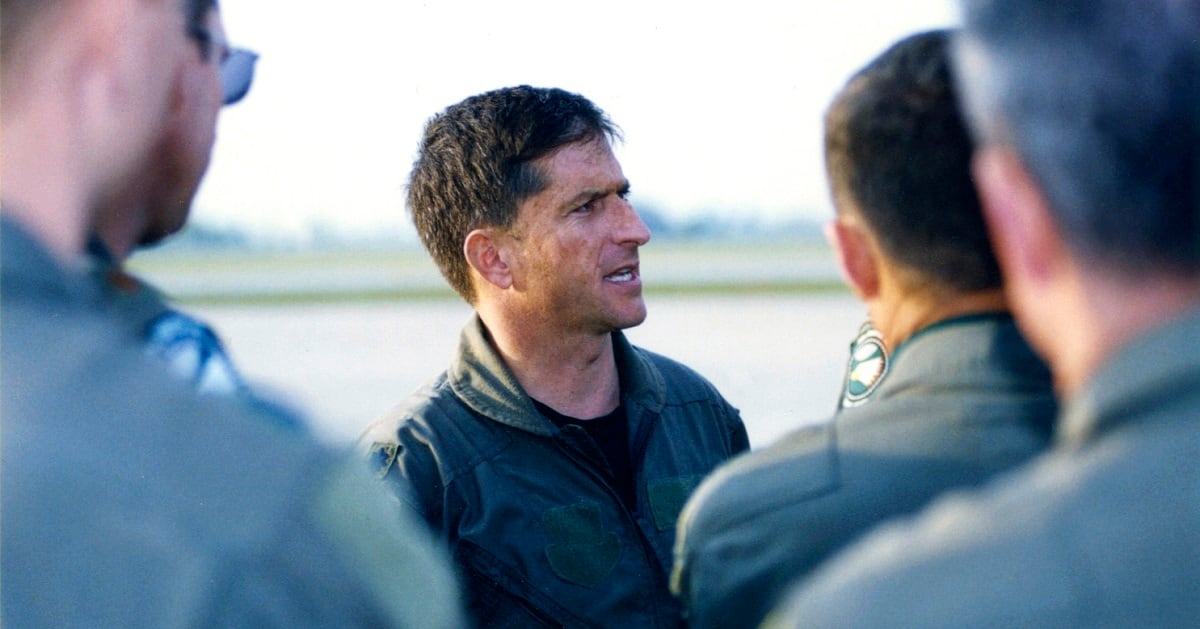
The F-16s began sweeping the area with their sensors to find the “hot spots” launching the enemy missiles, and firing AGM-88 High-speed Anti-Radiation Missiles, or HARMs, to take them out.
But another battery lurking right below Goldfein fired a missile practically straight up at him, and about four seconds later it slammed into the aft of his F-16.
“It’s the standard story everybody tells you,” Goldfein said in a May 7 interview at his Pentagon office. “The one I didn’t see was the one that hit me.”
Goldfein said the same Serb who shot down Lt. Col. Dale Zelko’s F-117A Nighthawk the fourth night of the campaign also shot him down, with the same skillfully jury-rigged SAM battery.
“He had done some creative modifying of his surface-to-air missiles,” Goldfein said. “We started nicknaming him the MacGuyver of Serbia. He was good.”
Two decades later, Goldfein holds no ill will toward that man, and even speaks of him with respect.
“He was doing his job; I was doing my job,” Goldfein said. “Nature of warfare.”
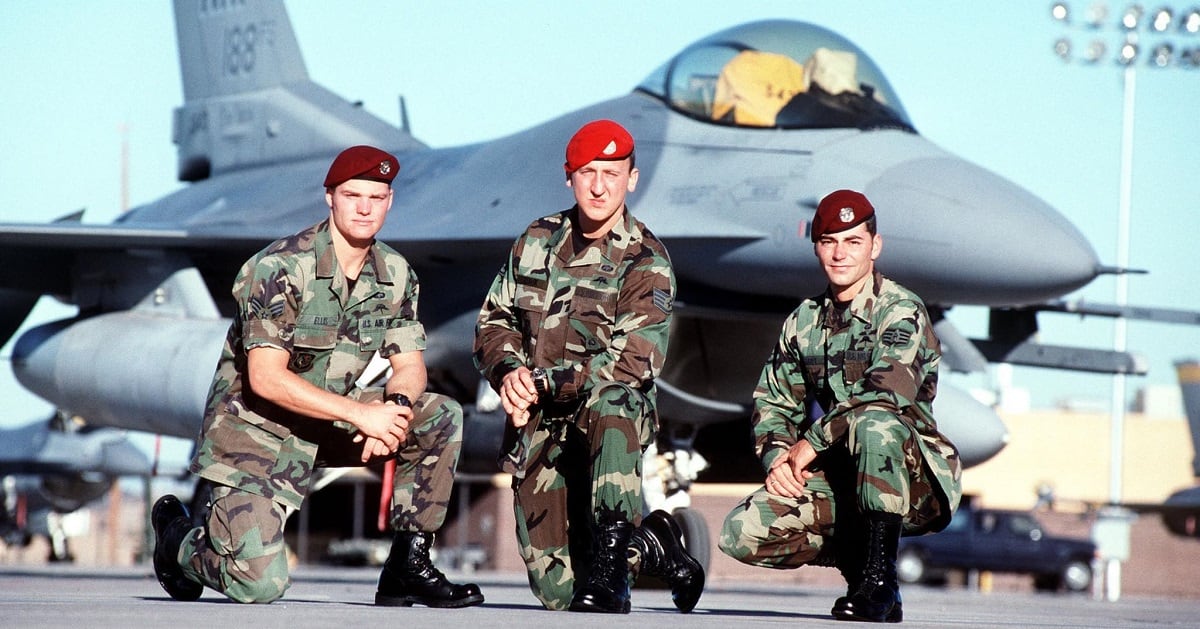
Goldfein said the impact felt like a lightning strike he had experienced during a flight a few months earlier, which caused minor damage to his fighter — “Big flash, loud explosion. My first thought was, wow, lightning just hit again.”
But Goldfein quickly realized he was in a lot worse shape this time. Smoke and fumes seeped into his vibrating cockpit, and he had trouble regaining control of his jet.
RELATED
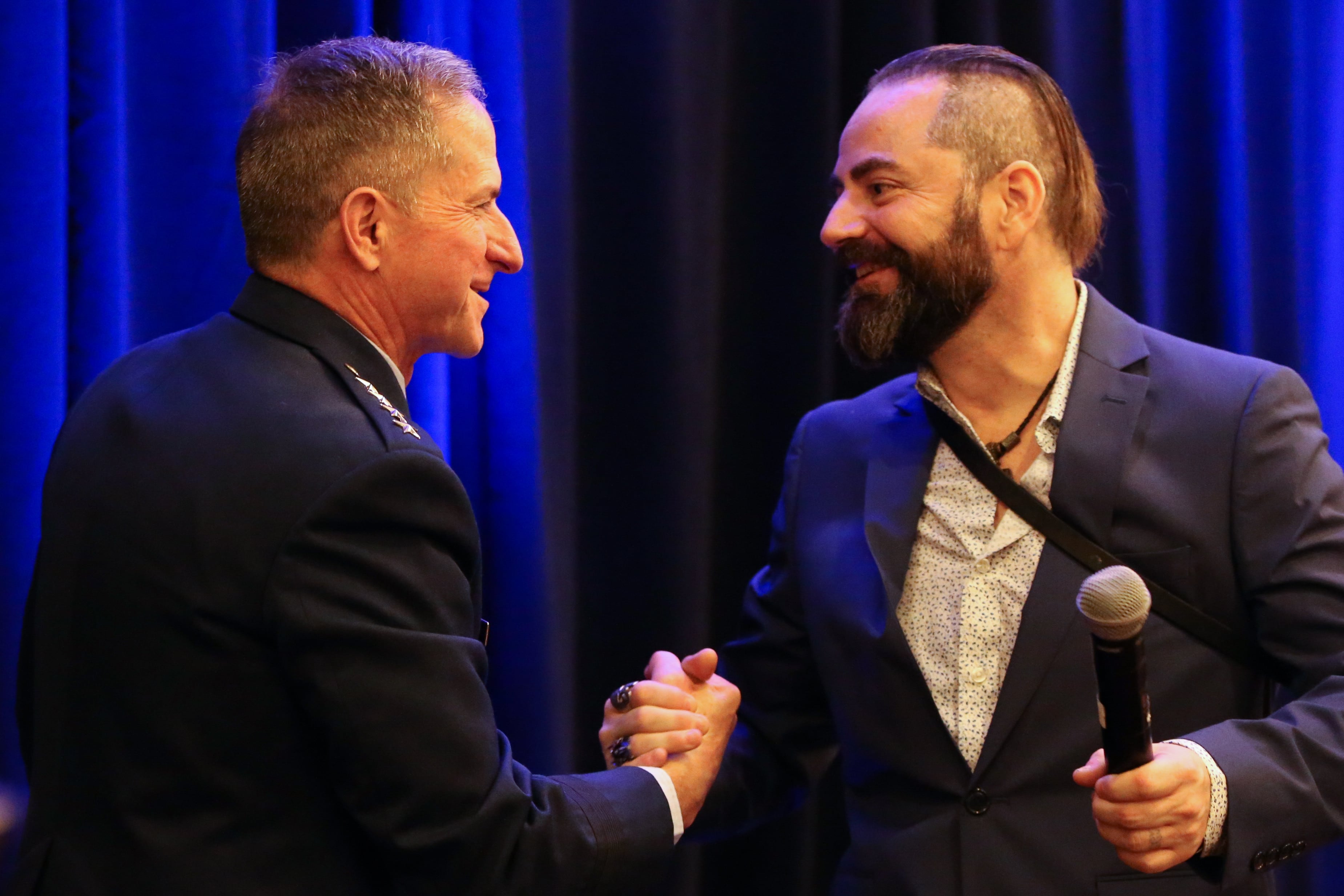
His training kicked in: He told his fellow pilots what was going on, and turned back west toward a safe base. Goldfein tried to tell his formation his heading, although the jet was shaking so violently he had a hard time reading the instruments.
Goldfein warned them, “Start finding me, boys” so someone could get a radar lock and last known position in case he had to bail out. The cockpit recording, which Goldfein confirmed was his, was recovered by the Serbs in the wreckage of his jet and has since made its way onto YouTube.
For the first minute or two, Goldfein thought he might still have a functional engine because he didn’t lose airspeed when he turned as rapidly as he thought he would if the F-16 engine was, indeed, dead. But within moments it went out completely.
“Then it was a recognition that, OK, I’m a really expensive glider,” Goldfein said. “Now the question is whether I’m going to be in it or not.”
He pushed the nose down to keep gliding — right back into the heart of the anti-aircraft artillery pit they had just flown over. He dodged a few AAA bursts as best he could in his thrust-less fighter, but they couldn’t find him. He unsuccessfully tried to restart the engine three times, while navigating to try to avoid villages and towns.
He knew he had to bail out. He did one last scan of his surroundings, made one last radio call, and took off his goggles. He secured pens and loose items in the cockpit for when the canopy blew. Then he took one last, farewell look at his F-16 with its Triple Nickel tail flash, reached down, and pulled the handle. It was a little before two in the morning.
THE WORD SPREADS
Almost immediately, word of the downed aircraft reached Tuzla Air Base in Bosnia and members of Air Force Special Operations Command’s 55th Special Operations Squadron.
Some airmen and soldiers were still up, playing cards in the tactical operations center. Retired Lt. Col. Bill Denehan, who was then a captain and pilot, had just turned in for the night. Nearby, Senior Airman Andy Kubik, the combat controller on Denehen’s MH-60 Pave Hawk, was lifting weights.
“Somebody came in through the door and said, ‘Hey, an F-16 went down — it’s real,’” said Kubik, who later retired as a technical sergeant. This time, it wasn’t one of the drills they had practiced night after night. “We’re like, damn.”
The 34 special tactics airmen and Army special forces A-Team troops on the rescue team were briefed, then boarded the Pave Hawk and two MH-53 Pave Lows. After a delay while a bigger task force was briefly considered — which would have cost the team precious darkness — the helicopters took off.
“We were worried,” Denehan said. “We did not want to go into Serbia in the daylight. It would have been a suicide mission.”
In the Pave Hawk was Denehan and Capt. Tom Kunkel, his co-pilot, as well as Kubik, pararescuemen Staff Sgt. Jeremy Hardy and Senior Airman Ron Ellis, and flight engineers Tech. Sgt. Jack Gainer and Staff Sgt. Rich Kelly manning the guns.

Back at Aviano, Dawn Goldfein suddenly woke up at about 1:45 a.m. with a sick feeling that something was wrong. Petty theft was a problem in that area, she said, and she first wondered if someone was lurking around her home. She looked through and outside her house and found nothing amiss. She went back to bed but couldn’t fall back to sleep.
‘WILE E. COYOTE’ IN SERBIA
As Goldfein drifted down, he looked up at his parachute and became immediately concerned. Whoever packed it didn’t give him the dark green combat chute he was supposed to have — he was instead floating down under an orange-and-white training chute, shining brightly under the full moon.
“That’s probably not good,” Goldfein thought.
Goldfein accelerated his descent with a four-line jettison method, which is typically too risky to be done at night, and spiraled down into a soft, freshly plowed field to avoid injuring himself upon landing.
He gathered up his parachute and the gear that had come out on a lanyard, including a raft and survival kit, so he didn’t leave a trace behind. The raft had inflated, so Goldfein shoved the parachute and its wire inside and grabbed it in front of him. Goldfein began running — as best he could carrying a raft — toward a treeline and what he thought was a nice, gentle hill.
That slope, however, turned out to be more like a cliff.
“So, I ended up looking like Wile E. Coyote, right? Sort of, ‘Beep beep,’” Goldfein said. “Luckily, I fall in this raft and I ride like Indiana Jones down to the bottom of this ravine, and then land in a pile of parachute material in a raft.”
Goldfein did catch one lucky break — he was now concealed in a pitch-black ravine deep in a treeline. He took out his radio and quietly sent a message.
For some unknown reason, Goldfein said, he became intensely focused on trying to destroy his raft. He first tried unsuccessfully to puncture the raft’s thick rubber with a stick, and then he got the idea to bite through it with his teeth, before catching himself.
“It’s crazy what goes through your mind,” Goldfein said. “All of a sudden, sanity gets there and says, ‘What’s going to happen when I actually do bite through this?’”
He instead buried his raft and unnecessary items under leaves and started moving toward higher ground.
That’s when he ran into three Serbian soldiers, hunting him down.
He first heard the voices of the search party, and hit the deck, concealed in tall grass just inside the treeline. The Serbs walked right towards him.
Goldfein slowly reached for his 9-millimeter Beretta pistol — but it was gone, lost during the ejection. He had only one option: He hugged the earth, and cautiously worked his way backwards. The Serbs came within 20 or 30 feet of him, but went on their way. After that close call, Goldfein was back on the move.
“I knew if these three guys had just come by that location, there were more to follow, and so I needed to get out of that area,” Goldfein said.
But Goldfein had a big problem: He didn’t know how far he had glided, and had no idea whether he had bailed out in Bosnia or Serbia. And if he was in Bosnia, he ran the risk of running into landmines.

“The question was: How do I not survive an ejection, survive a shoot-down, and then get blown up by stepping on a mine?” Goldfein said.
He decided his best strategy was to walk through the plowed fields, assuming that farmers would have already kicked up any possible landmines. The downside was, that meant he had no straight path to follow. Goldfein spent almost an hour weaving from tree line to tree line, working through plowed areas.
Finally, he made it to an ideal rescue spot: He had a tree line to his back, a field to his front with waist-high crops in which he could hide, and a pretty good sense of the direction from which the rescue helicopters might come.
With time to kill, in enemy territory, the only thing he could do at that point was hide and wait. He remembered a story from one of his Desert Storm squadron mates, who bailed out and kept his mind occupied by collecting rocks to give to his kids as souvenirs.
“I remember when he told me that story, I thought man, this guy is father of the year,” Goldfein said.
So Goldfein began collecting the best rocks he could find into a pile to give to his daughters when he saw them again. But then, he once again heard footsteps in the ravine behind him.
“Again, I hunker down and I think, damn it, I can’t believe these guys found me,” he said.
But when he listened closer to the crunches of the steps, he realized it wasn’t a person, but an animal of some kind. It drew closer to him, and Goldfein decided to scare it away.
“I grabbed some of these rocks in this great little pile that I have, and I fling it at this thing, and it rears up and growls,” Goldfein said. “I left that perfect spot. I always joke that I’m convinced it was a mountain lion or a grizzly bear, you know, there in Serbia. But a lot of people are convinced it was a Serbian field mouse.”
THE RESCUE
As the rescue helicopters flew over Serb-friendly Bosnian villages near the border, the people in their homes began dousing the lights, which Denehan said felt eerie. They took a roundabout route to the south to avoid the Serbian city of Loznica, which they suspected might have a large ground force and AAA.
They flew over the fog-filled Sava River valley, and then saw two or three bright, flaming balls shoot up on the horizon. Denehan’s first thought was, “Oh man, somebody’s getting shot at.”
Then he realized, that somebody was them.
The helicopters flew low, popping chaff and flare and trying to jam the enemy’s signal. Kubik recalled watching the school-bus-size Pave Lows pulling off radical maneuvers — rapidly moving left, right, up down — and swinging as he gripped the side of his own helicopter with all his might.
“It was like a roller coaster ride, just to avoid the missile,” Kubik said. “There was no time I was afraid, but it was a reality check. 'S---, this is real. This is definitely real. We’re going into a fight.’”
They soon shook those attackers, but it put them on notice: The Serbs knew they were coming.
They turned north back toward Bosnia, hoping to find a clearer way back into Serbia, when another SAM hurtled toward them. Denehan turned left, again popping chaff and flare, and dove his Pave Hawk to the deck to get some cover behind trees and large rocks. The missile went over them.
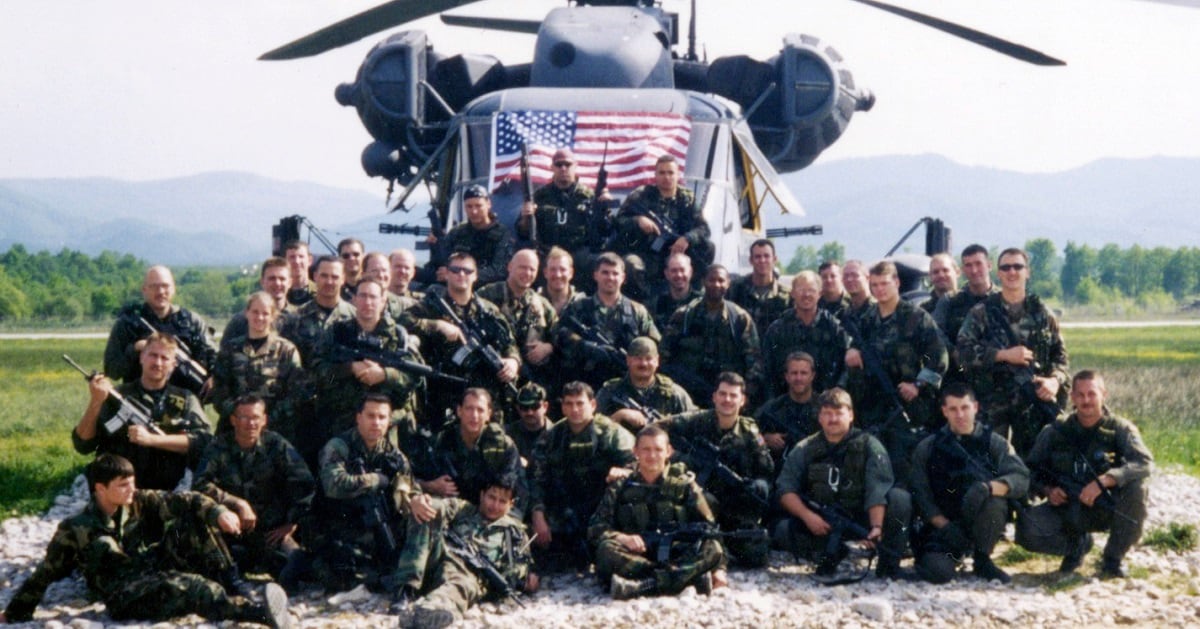
A gunner on one of the Pave Lows later told Denehan that given how much chaff and flare was coming out of the Pave Hawk and how close it dove to the ground, he briefly thought they were crashing.
After flying through the safer Bosnian airspace for a period, they re-entered Serbia and headed toward Goldfein. They weaved their way through the terrain, sometimes flying at 50 to 100 feet and popping over trees and power lines.
Someone opened fire on them from a building they passed on their right. Kelly, their gunner, immediately opened up with a minigun and swept the building until it “disappeared,” Kubik said.
After the fire stopped, Kelly heard a whistling in the blades. Later, after the mission concluded, they would find what appeared to be an AK-47 bullet hole in a rotor blade, and another in the fuselage above their heads. At the time, Denehan rocked and banked the helicopter to test it, and didn’t feel any problems, so they kept going.
The airmen thought they were closing in on their target when they saw a bright light erupt to their left. Believing it was Goldfein, popping off a flare, Gainer called out, “Survivor in sight!” Denehan’s Pave Hawk broke off toward some farm buildings — but what they saw turned out to be a farmer turning on his barn light, not Goldfein.
Confusion grew. They couldn’t talk to Goldfein; all their messages were getting relayed to the downed pilot through an A-10 flying overhead. The satcom became clogged with chatter until Gainer silenced everyone with a few well-placed profanities and a demand: “Clear this net, immediately!” Then they got new coordinates: Goldfein was 16 miles to their east, Denehan said, 60 miles east of Loznica.
Goldfein, meanwhile, still had no idea where he was. He couldn’t see the approaching rescue choppers at first, but he could hear them and coaxed them in — “I can hear you, you’re getting louder, keep coming in that direction.”
Goldfein saw the helicopters pass by and fumbled to activate his infrared strobe. Seeing it, Denehan quickly landed the Pave Hawk on the side of a hill at around 5 a.m. Goldfein was kneeling in a creek bed at the bottom, just outside of some trees. Denehan said he had to keep powering the helicopter to keep it from rolling over on the slope.
“Then the excitement began,” Goldfein said. “The enemy knew where we were, so they started racing. Now the fight’s on — who’s going to get there first?”
Kubik, Hardy and Ellis immediately jumped out — knocking a case of water onto the ground — and ran to Goldfein, who ran toward them, and they met in the middle. Kubik ran past him and eyed the tree line, expecting more Serbs.
Goldfein said they “were getting a lot of fire” at the scene of his rescue, and recalled machine gun fire being directed to the tree line near where he was. Denehan and Kubik recall it differently — the Serbs were firing at the Pave Lows slightly ahead of them, they said, but they weren’t dodging bullets at the Pave Hawk’s landing zone.
When his rescuers arrived, Goldfein put his arms over his head, showing his submission while the airmen confirmed it was him.
“Our total authentication was, ‘Let’s go,’" Goldfein said.
Then they heard ground fire aimed at the Pave Lows still in the air, and the Pave Lows firing back, and hustled Goldfein back to the helicopter.

“You could tell the way he looked, he wanted to get the hell out of there,” Kubik said.
The body-armored rescuers dog-piled on the unarmored Goldfein to protect him from stray bullets and began frantically shouting over the rotor noise, “Go, go, go!” The Pave Hawk lifted off, less than a minute after it first landed.
The Serbs fired at the Pave Hawk, and the pilots had to maneuver radically to dodge the shots. At one point, Goldfein said, it banked up — and he began sliding out because he wasn’t strapped down. He grabbed onto a seat and held on for dear life.
“I’ve joked with them over the years, wouldn’t that have been something?” Goldfein said. “‘Hey, where’s the pilot? I thought it was your turn to watch him.’”
The three helicopters began speeding toward the border as the sun began to rise, scanning the skyline for threats and dodging more AAA fire. Pave Lows are faster than a Pave Hawk, Denehan said, so he pushed his engine into the red to keep up with them.
“At this point, we just needed to get out of there,” Denehan said. “We had a full moon, so it was bright to begin with, but I’m noticing that it’s getting brighter and brighter. I look under the NVGs, and it’s pretty much dawn. I’m like, crap, this is not a good place to be.”
They landed at Tuzla and shut down while an MC-130 landed, ready to whisk Goldfein back to Aviano. Goldfein quickly thanked the crew and shook their hands, everybody slapped each other on the back. Then he was gone.
The rescuers circled around one another to tell war stories and figure out exactly what they had just gone through, looked at the holes in the helicopter, and then went for breakfast.
“It’s an adrenaline rush, you’re amped up,” Kubik said. “It’s almost disbelief — you can’t believe you pulled it off. We were all just in awe.”
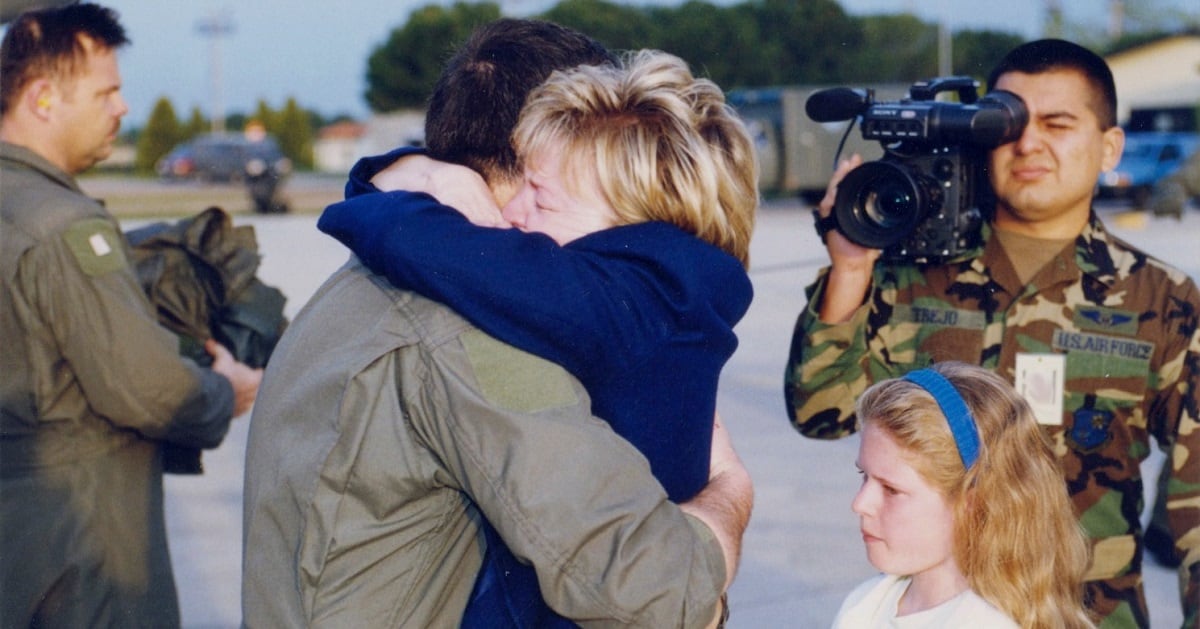
DAWN
After laying awake for hours, Dawn Goldfein heard the phone ring at about 5:30 a.m. and shot out of bed. It was Brig. Gen. Dan Leaf, commander of the 31st Air Expeditionary Wing at Aviano, telling Dawn, “It’s good news,” and that Leaf’s wife would be at her home in 10 minutes.
Dawn assumed something had happened to another pilot in the squadron, and she would have to comfort that pilot’s wife. She got dressed, cleaned up the living room, and made coffee while she waited. When her doorbell rang, she found the wing commander’s wife, the chief of flight medicine and her priest.
“I knew instantly it was Dave,” Dawn said. They knew he had been shot down, and that he was coming back, but nobody knew his condition.
A million thoughts blurred through Dawn’s head as she invited them in. She remembered friends who had been shot down during Desert Storm and were brought home on stretchers with broken bones.
“What shape was he going to be in?” Dawn wondered. “I was trying to wrap my brain around the thought that my world might be completely different, and I worried for my daughters.”
When they got word that the MC-130 was about to land, Dawn woke up their eldest daughter, Danielle — who is now an Air Force officer — and told her what had happened. She tried to stay positive despite her fears. Fortunately, Dawn said, their youngest daughter was at a friend’s house for a sleepover and had no idea what was transpiring.
Dawn said that waiting on the flightline was an amazing moment, as she saw a sea of green uniforms gathering around, waiting to welcome back her husband. She saw the other three pilots from Goldfein’s formation, and they had been crying — “Obviously, it was a really tough night for them.”
The airplane landed and lowered its stairs, Dawn said, and Goldfein emerged a muddy mess.
“It was the most beautiful sight I’d ever seen,” she said.
She held back from hugging her husband until the three pilots had had a chance to welcome him back. And when Danielle, who had been waiting very patiently, finally hugged her father, “the whole time we were there on the flightline, she never let him go after that.”
‘BEST OF THE BEST’
Kubik feels pride when he looks back on what they accomplished that day.
“Those pilots — I’m not bragging, but I think we were the best of the best. All of us were, at that time,” he said.
When Goldfein talks about the mission, his deep respect for all those who rescued him — not only Hardy, Kubik and Ellis, but the other airmen and soldiers on the three helicopters and those supporting the mission — is readily apparent.
“My role, quite frankly, was just not to screw it up,” Goldfein said. “These guys … they knew exactly what they needed to do. They were not going to give up, come hell or high water.”
Over the years, Goldfein has tried to help them heal the physical and emotional wounds they suffered in war — particularly Andy Kubik.
Four years ago, Goldfein found and got Kubik into the Eisenhower Center, a private health care facility on a farm in Michigan that specializes in military service members, first responders and NFL players with traumatic head injuries. There, Kubik received the treatment for his post-traumatic stress and substance abuse he had needed for years.
“He was there for me when I had problems,” Kubik said. “He bailed me out of jail, and got me set up with a hospital. I’ve been jailed nine times and hospitalized 14 times. It wasn’t until he got involved, at the end, that it all stopped.”
And for Goldfein, his efforts to repay the debt he owes his rescuers comes down to something very simple.
“They didn’t leave me; I’m sure not going to leave them,” he said.
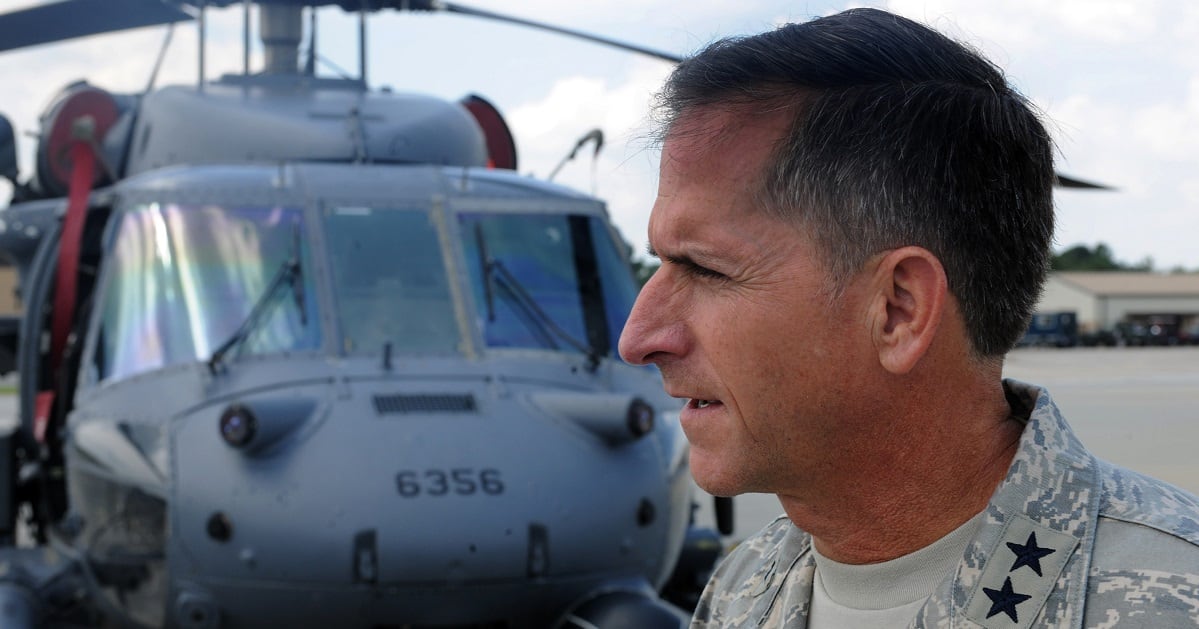
Stephen Losey is the air warfare reporter for Defense News. He previously covered leadership and personnel issues at Air Force Times, and the Pentagon, special operations and air warfare at Military.com. He has traveled to the Middle East to cover U.S. Air Force operations.



